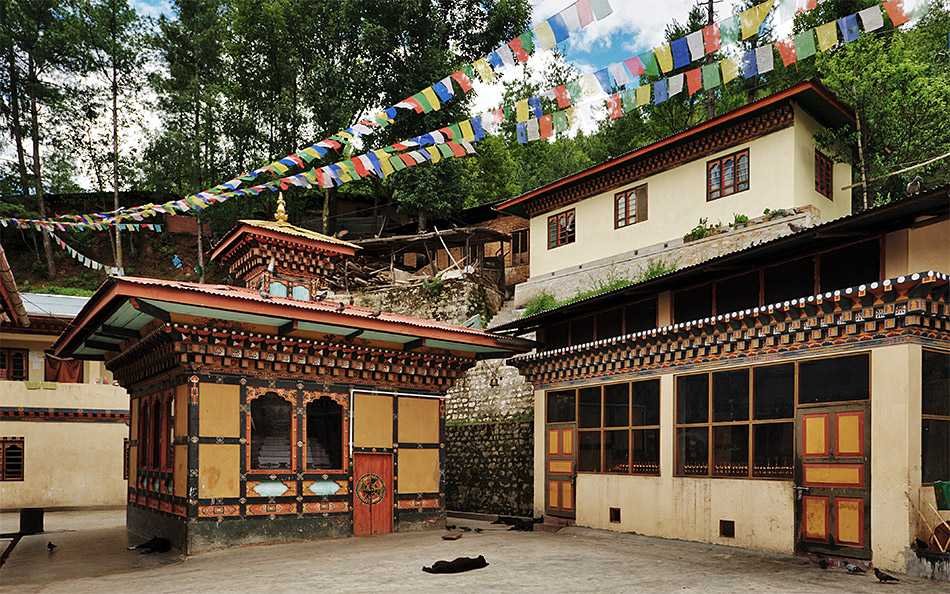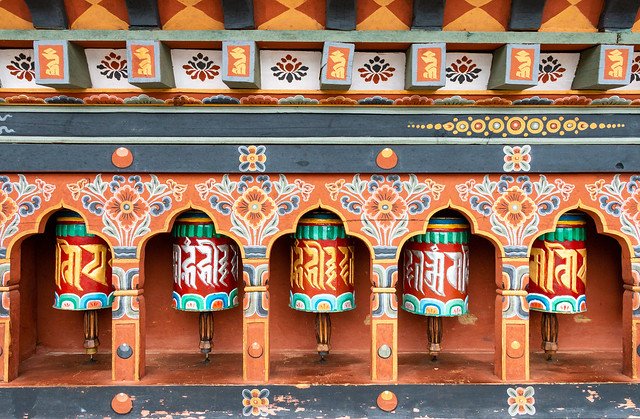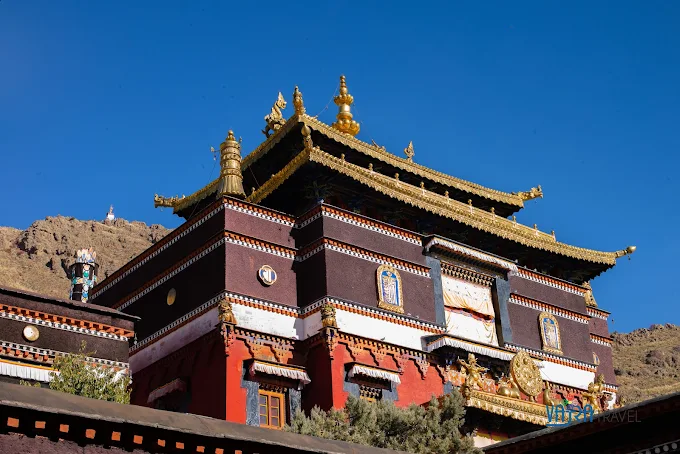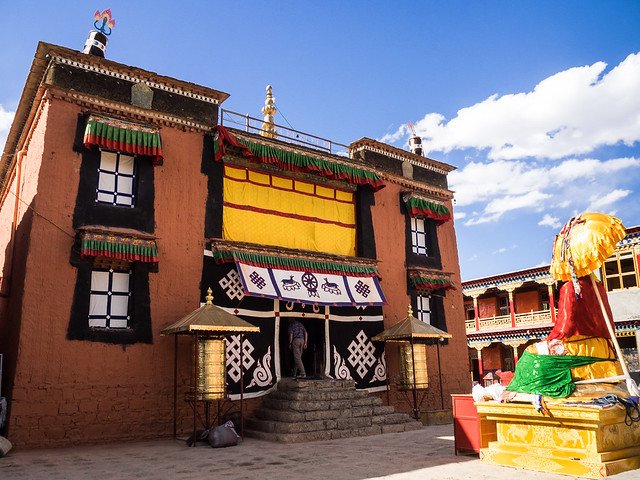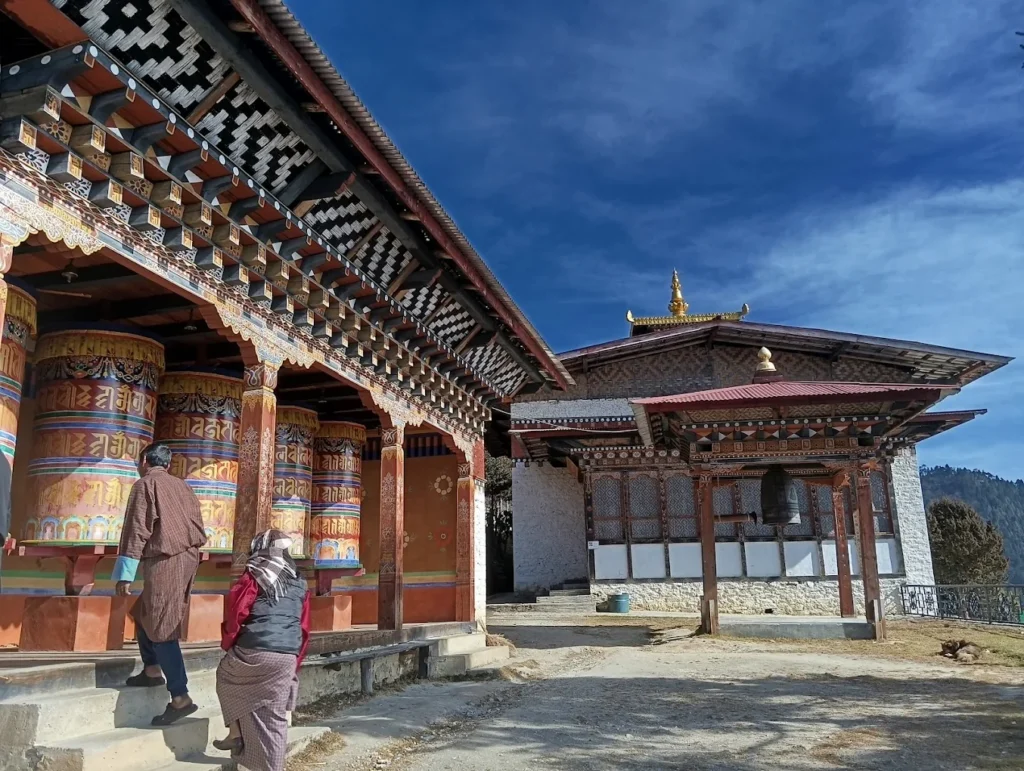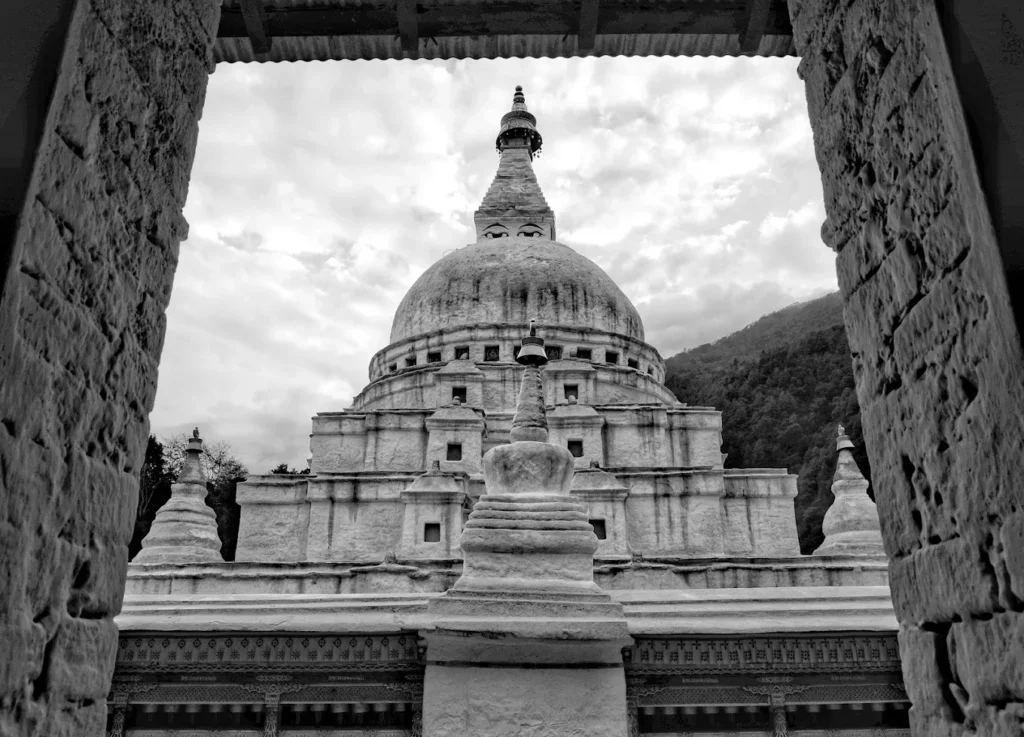Zilukha Nunnery: The Serene Haven of Thimphu’s Spiritual Heart
In the early morning mist of Thimphu Valley, the soft chants of nuns drift from Zilukha Nunnery, perched on a gentle slope overlooking the majestic Tashichho Dzong. Known as Thangthong Dewachen Nunnery or Zilukha Anim Dratshang, this sacred site hums with the rhythmic turning of prayer wheels and the glow of butter lamps, illuminating statues of Thangtong Gyalpo, White Tara (Drol-kar), and Neten Yenla Jung. Founded in 1976 by Drubthob Rikey Jadrel, the 16th emanation of the revered Thangtong Gyalpo, the nunnery houses around 60–70 nuns who dedicate their lives to Buddhist study and community service. The serene courtyard, centered by an enclosed chorten [stupa], invites visitors to pause and absorb the tranquility, while the distant silhouette of the Dzong frames a breathtaking view. This vibrant spiritual hub, rooted in the Nyingma and Shangpa lineages, embodies Bhutan’s living Buddhist heritage, drawing travelers and seekers to its peaceful embrace.
Echoes of Compassion: Overview and Significance
Zilukha Nunnery stands as a cornerstone of Bhutanese spirituality, blending historical reverence with contemporary community engagement. Its establishment in 1976 by Drubthob Rikey Jadrel, an emanation of the 14th-century Mahasiddha Thangtong Gyalpo, marks it as a modern yet deeply rooted institution. The nunnery’s commitment to empowering women through Buddhist education reflects Bhutan’s evolving cultural landscape, while its scenic location above Thimphu Valley enhances its spiritual allure.
Historical Roots and Legacy
Zilukha Nunnery’s origins are tied to Thangtong Gyalpo (1361–1485), a Tibetan polymath renowned for constructing iron chain bridges, founding Tibetan opera, and advancing Vajrayana Buddhism. His 16th emanation, Rikey Jadrel (1901–1984), built the nunnery in 1976 to promote Buddhist teachings, particularly those of the Jangter lineage and Abham Terchoe of the Nyingma School. The temple, constructed in 1983, houses relics like Guru Padmasambhava’s dorje [ritual thunderbolt], believed to clear obstacles. Unlike older Bhutanese sites, Zilukha’s modern founding reflects a deliberate effort to sustain female monasticism.
- Key Milestones:
- 1976: Nunnery founded with 45 nuns, later growing to 60–70.
- 1983: Central temple built, enshrining Thangtong Gyalpo’s statue.
- Ongoing: Supported by the Bhutan Nuns Foundation, founded in 2009 under Her Majesty Tshering Yangdoen Wangchuck.
Cultural and Spiritual Significance
Zilukha Nunnery serves as a spiritual anchor in Thimphu, offering rituals and prayers for local residents and visitors. Its focus on the Nyingma School’s Jangter lineage emphasizes meditative practices like Dzogchen [Great Perfection], which seeks to uncover the mind’s innate clarity. The nunnery’s role in educating women aligns with Bhutan’s Gross National Happiness philosophy, fostering gender equity in spiritual practice. Its prominence as the largest nunnery in Bhutan underscores its influence in preserving Buddhist heritage.
- Cultural Roles:
- Educates nuns in Buddhist philosophy, empowering them as community leaders.
- Hosts rituals that reinforce Bhutan’s Vajrayana identity.
- Attracts global pilgrims seeking authentic Buddhist experiences.
Community and Global Connections
The nunnery’s impact extends beyond Thimphu through community service and international engagement. Nuns participate in programs like the Bhutan Nuns Foundation’s initiatives, which address social issues such as youth disenchantment and addiction. The Zilukha Project, inspired by Thangtong Gyalpo’s legacy, engages children and youth with creative Buddhist programs, fostering cultural resilience. Globally, the nunnery draws visitors from Asia, Europe, and North America, who interact with nuns to learn about Bhutanese Buddhism.
- Community Impact:
- Provides spiritual services, including obstacle-clearing rituals.
- Engages youth through Jataka Tale workshops and contemplative arts.
- Supported by royal patronage, enhancing its national significance.
As the morning chants fade, the nunnery’s legacy of compassion and education lingers, bridging Thangtong Gyalpo’s ancient wisdom with Bhutan’s modern aspirations. Its serene perch above the valley invites deeper exploration of its architectural and spiritual treasures.
Sacred Spaces: Architectural and Spiritual Features
Zilukha Nunnery’s design reflects Bhutanese architectural traditions, harmonizing with its hillside setting. Built in 1976, its structures embody simplicity and functionality, with the 1983 temple as its spiritual heart. The nunnery’s layout, centered around a courtyard with an enclosed chorten, fosters contemplation, while its statues and relics radiate sacred energy.
Iconic Design and Structures
The nunnery’s traditional Bhutanese architecture features whitewashed walls, wooden beams, and a sloping roof adorned with colorful motifs. Perched above Gaden Lam, it overlooks the Thimphu Valley, with Tashichho Dzong visible below. The main temple, built in 1983, is flanked by living quarters for 60–70 nuns, creating a compact, communal space. The courtyard’s chorten, a unique feature, serves as a focal point for circumambulation.
- Design Highlights:
- Whitewashed stone walls with intricate woodwork.
- Courtyard chorten, symbolizing enlightenment.
- Elevated location, integrating with the natural slope.
Sacred Statues and Relics
The temple houses three central statues: Thangtong Gyalpo, White Tara, and Neten Yenla Jung (Angiraja), one of the Sixteen Arhats. Thangtong Gyalpo’s statue, crafted in gilded bronze, depicts him with a meditative gaze, symbolizing his yogic mastery. White Tara, known for compassion and longevity, is adorned with silks and jewels, her serene expression captivating devotees. Neten Yenla Jung’s statue emphasizes wisdom and renunciation. A dorje attributed to Guru Padmasambhava enhances the temple’s sanctity.
- Statue Details:
- Thangtong Gyalpo: Gilded bronze, central figure, ~1.5 meters tall.
- White Tara: Ornate, with seven eyes symbolizing omniscience.
- Neten Yenla Jung: Simple yet dignified, reflecting Arhat austerity.
Artistry and Environmental Harmony
The nunnery’s artistry lies in its subtle yet vibrant details, from painted mandalas on temple walls to carved wooden beams. Local artisans, trained in Bhutan’s Zorig Chusum [13 traditional crafts], contributed to its construction, using sustainable materials like timber and stone. The nunnery’s hillside location aligns with Bhutanese principles of environmental harmony, with minimal disruption to the natural landscape.
- Artistic Features:
- Mandala frescoes depicting Buddhist cosmology.
- Wooden carvings of auspicious symbols like the Eight Lucky Signs.
- Eco-friendly design, blending with the valley’s contours.
The nunnery’s serene architecture and sacred relics create a space where spirituality and nature intertwine, guiding visitors toward its vibrant rituals and practices.
Living Traditions: Rituals and Practices
Zilukha Nunnery pulses with daily and seasonal rituals, rooted in the Nyingma and Shangpa lineages. The nuns’ practices, from chanting to community engagement, embody Bhutanese Buddhism’s living essence, offering visitors a glimpse into a disciplined yet compassionate way of life.
Daily and Unique Rituals
Each day begins with sunrise chants, as nuns recite sutras and mantras, such as the White Tara mantra for longevity. Prayer wheels spin continuously, accumulating merit for the community. Unique to Zilukha, obstacle-clearing rituals using Guru Padmasambhava’s dorje are performed, believed to dispel negative forces. These practices, grounded in Dzogchen, emphasize meditative awareness.
- Daily Practices:
- Morning sutra recitations, ~2 hours.
- White Tara mantra chanting for compassion and health.
- Dorje rituals for spiritual purification.
Festival Traditions
Zilukha hosts annual festivals, notably Losar [Bhutanese New Year] and Dromche, which honor Thangtong Gyalpo and other deities. During Losar, nuns perform cham [sacred dances] and offer torma [ritual cakes], drawing local crowds. These festivals, held in February or March, feature vibrant processions and communal prayers, distinct from daily routines.
- Festival Highlights:
- Losar: Cham dances and torma offerings, 3–5 days.
- Dromche: Devotional ceremonies for Thangtong Gyalpo.
- Community participation, enhancing festive vibrancy.
Community and Visitor Engagement
Nuns engage the community through spiritual services and educational outreach, supported by the Bhutan Nuns Foundation. Visitors are welcomed to join prayers or interact with nuns, learning about Buddhist philosophy and female monastic life. These interactions, encouraged during morning hours, foster mutual respect and cultural exchange.
- Engagement Activities:
- Guided prayer sessions for visitors, ~30 minutes.
- Educational talks on Nyingma teachings.
- Youth programs via the Zilukha Project, teaching Jataka Tales.
The nunnery’s rituals, steeped in devotion, pave the way for practical guidance, ensuring visitors can fully immerse themselves in its sacred ambiance.
Journey to Zilukha: Visitor Information
Zilukha Nunnery, a short drive from Thimphu’s bustling center, offers a tranquil retreat for travelers. Its accessibility, combined with cultural etiquette and nearby attractions, makes it an ideal destination for spiritual seekers and cultural explorers.
Navigating the Nunnery
Located along Gaden Lam, above the Royal Thimphu Golf Course, the nunnery is a 10–15-minute drive from Thimphu’s main town. Visitors can follow the road past the golf course, ascending a gentle slope to the nunnery’s entrance. Landmarks like the Tashichho Dzong, visible below, guide the way. A short walk from the parking area leads to the courtyard.
- Navigation Tips:
- Follow Gaden Lam from Thimphu town.
- Look for signs to Zilukha Anim Dratshang.
- Expect a 5-minute walk from parking to entrance.
Practical Details and Etiquette
The nunnery is open daily from 6 AM to 6 PM, with no entry fee, though donations are appreciated. Visitors must dress modestly (long sleeves, no shorts) and remove shoes before entering the temple. Photography is prohibited inside the temple but allowed in the courtyard. The full address is Gadhen Lam, Zilukha, Thimphu 11001, Bhutan. Accessibility is limited for wheelchairs due to steps.
- Logistics:
- Address: Gadhen Lam, Zilukha, Thimphu 11001, Bhutan.
- Hours: 6 AM–6 PM, daily.
- Transport: Taxi (~Nu 150 from town) or private vehicle.
- Etiquette: Silence phones, avoid pointing at statues, donate if possible.
Immersive Experiences and Surroundings
Visitors can light butter lamps in the courtyard (free) or join morning prayers for a meditative experience. Interacting with nuns offers insights into their lives, best done respectfully during non-ritual hours. Nearby, the Motithang Takin Preserve (6-minute drive) showcases Bhutan’s national animal, while Sangaygang Viewpoint (10-minute drive) offers panoramic Thimphu views.
- Immersive Tips:
- Light a butter lamp for blessings.
- Visit during morning chants for spiritual immersion.
- Explore nearby Takin Preserve and Sangaygang Viewpoint.
Zilukha’s accessibility and cultural richness prepare visitors to delve deeper into its philosophical and symbolic significance, connecting them to Bhutan’s spiritual core.
Wisdom of Zilukha: Cultural and Spiritual Insights
Zilukha Nunnery offers profound insights into Bhutanese Buddhism, weaving philosophical depth with cultural symbolism. Its role in empowering women and fostering community resilience underscores its enduring relevance.
Philosophical Foundations
The nunnery’s Nyingma practices, particularly Dzogchen, teach that the mind’s true nature is pure and luminous. Dzogchen meditation, practiced by the nuns, involves resting in natural awareness, free from conceptual thought, aiming for liberation. This philosophy, accessible to visitors through nun interactions, emphasizes compassion and mindfulness, aligning with Bhutan’s Gross National Happiness ethos.
- Key Concepts:
- Dzogchen: Non-dual awareness, cultivated through meditation.
- Compassion: Embodied in White Tara’s iconography and rituals.
Cultural and Symbolic Depth
The nunnery’s art and rituals are rich with symbolism. The chorten in the courtyard represents the Buddha’s mind, guiding devotees toward enlightenment. Mandalas on temple walls depict interconnectedness, reinforcing Buddhist cosmology. These symbols, explained during visitor interactions, deepen cultural understanding.
- Symbolic Elements:
- Chorten: Symbol of enlightenment and stability.
- Mandalas: Visual aids for meditation and cosmic unity.
Community and Environmental Resilience
Zilukha’s nuns contribute to community welfare through prayers and outreach, supported by the Bhutan Nuns Foundation. Their eco-conscious lifestyle, using sustainable materials, reflects Bhutan’s environmental ethos. Programs like the Zilukha Project engage youth, ensuring cultural continuity amidst modernization.
- Resilience Efforts:
- Youth workshops on Buddhist values.
- Sustainable practices, minimizing environmental impact.
The nunnery’s teachings and symbols resonate with universal themes of compassion and harmony, inviting visitors to experience its transformative power firsthand.
Why You Have to Get to Zilukha Nunnery
Zilukha Nunnery is a must-visit for its serene beauty, vibrant spirituality, and cultural significance. Perched above Thimphu Valley, it offers a rare glimpse into Bhutanese female monasticism, where 60–70 nuns uphold the Nyingma lineage through chants, rituals, and community service. The temple’s statues of Thangtong Gyalpo, White Tara, and Neten Yenla Jung, alongside Guru Padmasambhava’s dorje, radiate sacred energy, while the courtyard chorten invites quiet reflection. Its role in empowering women and engaging youth through the Zilukha Project underscores its modern relevance. As the sun sets, casting a golden glow over Tashichho Dzong below, Zilukha beckons travelers, seekers, and researchers to immerse themselves in its tranquil embrace, where Bhutan’s past and present converge in harmony.
